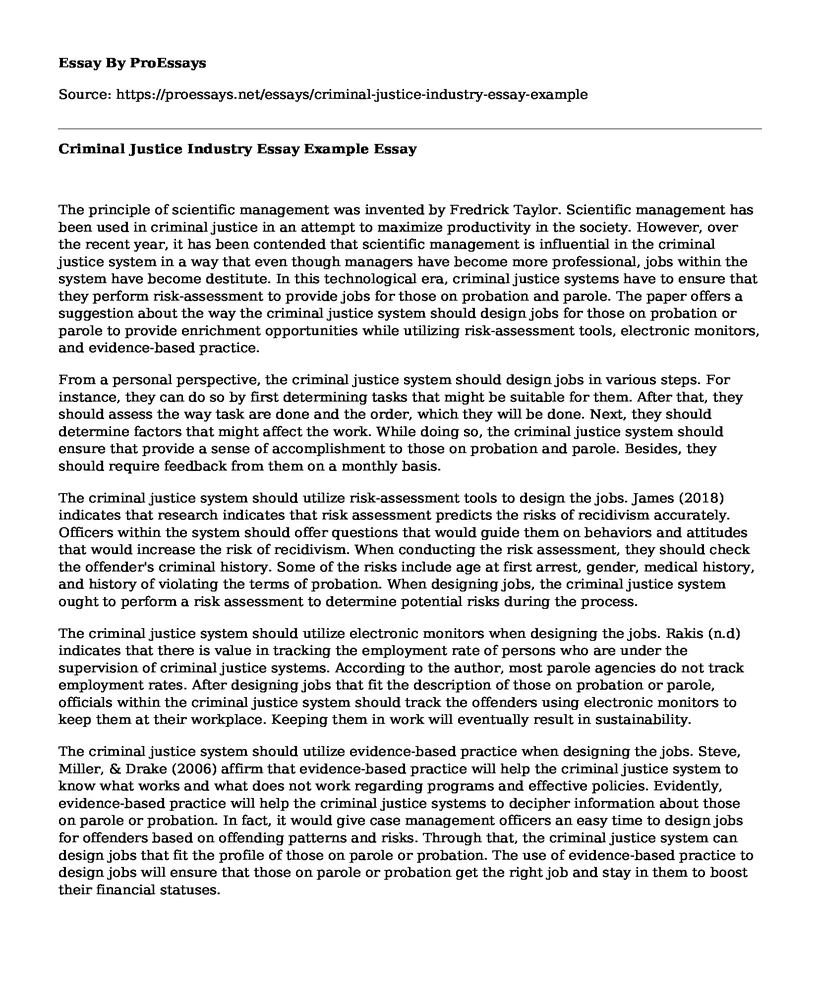The principle of scientific management was invented by Fredrick Taylor. Scientific management has been used in criminal justice in an attempt to maximize productivity in the society. However, over the recent year, it has been contended that scientific management is influential in the criminal justice system in a way that even though managers have become more professional, jobs within the system have become destitute. In this technological era, criminal justice systems have to ensure that they perform risk-assessment to provide jobs for those on probation and parole. The paper offers a suggestion about the way the criminal justice system should design jobs for those on probation or parole to provide enrichment opportunities while utilizing risk-assessment tools, electronic monitors, and evidence-based practice.
From a personal perspective, the criminal justice system should design jobs in various steps. For instance, they can do so by first determining tasks that might be suitable for them. After that, they should assess the way task are done and the order, which they will be done. Next, they should determine factors that might affect the work. While doing so, the criminal justice system should ensure that provide a sense of accomplishment to those on probation and parole. Besides, they should require feedback from them on a monthly basis.
The criminal justice system should utilize risk-assessment tools to design the jobs. James (2018) indicates that research indicates that risk assessment predicts the risks of recidivism accurately. Officers within the system should offer questions that would guide them on behaviors and attitudes that would increase the risk of recidivism. When conducting the risk assessment, they should check the offender's criminal history. Some of the risks include age at first arrest, gender, medical history, and history of violating the terms of probation. When designing jobs, the criminal justice system ought to perform a risk assessment to determine potential risks during the process.
The criminal justice system should utilize electronic monitors when designing the jobs. Rakis (n.d) indicates that there is value in tracking the employment rate of persons who are under the supervision of criminal justice systems. According to the author, most parole agencies do not track employment rates. After designing jobs that fit the description of those on probation or parole, officials within the criminal justice system should track the offenders using electronic monitors to keep them at their workplace. Keeping them in work will eventually result in sustainability.
The criminal justice system should utilize evidence-based practice when designing the jobs. Steve, Miller, & Drake (2006) affirm that evidence-based practice will help the criminal justice system to know what works and what does not work regarding programs and effective policies. Evidently, evidence-based practice will help the criminal justice systems to decipher information about those on parole or probation. In fact, it would give case management officers an easy time to design jobs for offenders based on offending patterns and risks. Through that, the criminal justice system can design jobs that fit the profile of those on parole or probation. The use of evidence-based practice to design jobs will ensure that those on parole or probation get the right job and stay in them to boost their financial statuses.
Conclusion
There is a correlation between employability and recidivism. Those on probation or parole face complex and enormous challenges regarding employment opportunities when they return to their communities. For that reason, criminal justice systems have to ensure that they offer the correct jobs to those on probation or parole to avoid reoffending. In essence, a good job is a deterrent to criminal behavior. It would be impossible for those on probation and parole to maintain good behavior when they have not secured good employment. Besides, they would be unable to take care of their families, thus leading to impoverishment. When they become poor, the will be likely to return to crime. Overall, if the criminal justice system follows the steps mentioned above, they would provide enrichment opportunities while still utilizing risk-assessment tools, electronic monitors, and evidence-based practice.
References
James, N. (2018). Risk and Needs Assessment in the Federal Prison System. Congressional
Research Service Report. Retrieved from https://fas.org/sgp/crs/misc/R44087.pdf
Rakis (n.d). Improving the Employment Rates of Ex-prisoners under Parole. Federal Probation.A journal of correctional philosophy and practice, vol.69 number 1.
Steve, A., Miller, M., & Drake, E. (2006). Evidence-based Adult Corrections Programs: What
Works and What Does Not. Olympia: Washington State Institute for Public Policy. Retrieved from http://www.wsipp.wa.gov/ReportFile/924
Cite this page
Criminal Justice Industry Essay Example. (2022, Jul 01). Retrieved from https://proessays.net/essays/criminal-justice-industry-essay-example
If you are the original author of this essay and no longer wish to have it published on the ProEssays website, please click below to request its removal:
- Development of Intellectual Property in the World Essay
- Expository Essay on Key Terms in Criminal and Civil Law
- Essay Example on Carrying Concealed Weapons: Majority of US States Allow It
- Reforming US Prisons: A Debate Among Leaders and Criminal Law Researchers - Essay Sample
- Essay on Privacy, Ethics, & Data Protection: Seeking & Sharing Sensitive Information
- Essay Example on Prisoner Rights in US Supreme Court: Brown v Plata Case
- Paper Example on Sarah and Michael: Unpacking Wealthy's Crimes and More on YWA







